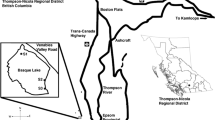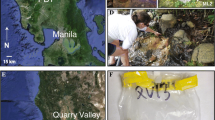Abstract
This study investigated the distribution of bacteria in groundwater from 16 different levels in five boreholes in granite bedrock down to a maximum of 860 m. Enrichment cultures were used to assay the groups of bacteria present. Autoradiographic studies with14C- or3H-labeled formate, methanol, acetate, lactate, glucose, sodium bicarbonate, leucine, glutamine, thymidine, orN-acetyl-glucosamine were used to obtain information about bacteria active in substrate uptake. The biofilm formation potential was studied in one borehole. The chemical environment in the groundwater was anaerobic with an Eh between −112 and −383 mV, a pH usually around 8, and a temperature range of 10.2 to 20.5°C, depending on the depth. The organic content ranged between <0.5 and 9.5 mg total organic carbon liter−1. Carbon dioxide, hydrogen, hydrogen sulfide, and methane were present in the water. The nitrate, nitrite, and phosphate concentrations were close to, or below, the detection limits, while there were detectable amounts of NH +4 in the range of 4 to 330 μg liter−1. The average total number of bacteria was 2.6×105 bacteria ml−1, as determined with an acridine organge direct-count (AODC) technique. The average number of bacteria that grew on a medium with 1.5 g liter−1 of organic substrate was 7.7×103 colony-forming units (CFU) ml−1. The majority of these were facultatively anaerobic, gram-negative, nonfermenting heterotrophs. Enrichment cultures indicated the presence of anaerobic bacteria capable of growth on C-1 compounds and hydrogen, presumably methanogenic bacteria. Most probable number assays with sulfate and lactate revealed up to 5.6×104 viable sulfate-reducing bacteria per ml. A biofilm development experiment indicated an active attached microbial population. Active substrate uptake could not be registered with the bulk water populations, except for an uptake of leucine not associated with growth. The bulk water microbial cells in deep groundwater may be inactive cells detached from active biofilms on the rock surface.
Similar content being viewed by others
References
Alföldi L (1988) Groundwater microbiology: Problems and biological treatment—state-of-theart report. Wat Sci Technol 20:1–31
Beeman RE, Suflita JM (1987) Microbial ecology of a shallow unconfined groundwater aquifer polluted by municipal landfill leachate. Microb Ecol 14:39–54
Beveridge TJ, Fyfe WS (1985) Metal fixation by bacterial cell walls. Can J Earth Sci 22:1893–1898
Bitton G, Marshall KC (1980) Adsorption of microorganisms to surfaces. John Wiley & Sons, New York
Characklis WG (1984) Biofilm development: A process analysis. In: Marshall KC (ed) Microbial adhesion and aggregation. Dahlem konferenzen 1984, Springer-Verlag, Berlin, pp 137–157
Ferris FG, Schultze S, Witten TC, Fyfe WS, Beveridge TJ (1989) Metal interactions with microbial biofilms in acidic and neutral pH environments. Appl Environ Microbiol 55:1249–1257
Fliermans CB, Balkwill DL (1989) Microbial life in deep terrestrial subsurfaces. Bioscience 39: 370–377
Ghiorse WC, Wilson JT (1988) Microbial ecology of the terrestrial sub-surface. Adv Appl Microbiol 33:107–172
Gustafson G, Stanfors R, Wikberg P (1988) Swedish hard rock laboratory first evaluation of prein vestigations 1986–1987 and target area characterization. SKB Technical report, 1988, 88–16, Stockholm. Available from SKB, Box 5864, 102 48 Stockholm, Sweden
Gustafson G, Stanfors R, Wikberg P (1989) Swedish hard rock laboratory first evaluation of prein vestigations 1988 and target area characterization. SKB Technical report, 1989, 89-16,
Hirsch P, Rades-Rohkohl E (1988) Some special problems in the determination of viable counts of groundwater microorganisms. Microb Ecol 16:99–113
Hobbie JE, Daley RJ, Jasper S (1977) Use of nuclepore filters for counting bacteria by fluorescence microscopy. Appl Environ Microbiol 33:1225–1228
Ingraham JL, Maalöe O, Neidharde FC (1983) Growth of the bacterial cell. Sinauer Associates, Inc., Massachusetts
Jardim WF, Pearson HW (1984) A study of the copper-complexing compounds released by some species of cyanobacteria. Wat Res 18:985–989
KBS (1983) Final storage of spent nuclear fuel—KBS-3, Part I–IV, Report by Swedish Nuclear Fuel Supply Co, SKBF/KBS, Stockholm. Available from SKB, Box 5864, 102 48 Stockholm, Sweden, tel. 46-8-665 28 00
Kirchman D, Ducklow H, Mitchell R (1982) Estimates of bacterial growth from changes in uptake rates and biomass. Appl Environ Microbiol 44:1296–1307
Kjelleberg S, Hermansson M, M»rden P, Jones GW (1987) The-transient phase between growth and non growth of heterotrophic bacteria, with emphasis on the marine environment. Ann Rev Microbiol 41:25–49
Marshall KC (1984) Microbial adhesion and aggregation. Springer-Verlag, Berlin
Marxsen J (1988) Investigations into the number of respiring bacteria in groundwater from sandy and gravelly deposits. Microb Ecol 16:65–72
McFeters GA, Bazin MJ, Bryers JD, Caldwell DE, Characklis WG, Lund DB, Mirelman D, Mitchell R, Schubert RHW, Tanaka T, White DC (1984) Biofilm development and its consequences. Group report. In: Marshall KC (ed) Microbial adhesion and aggregation. Dahlem konferenzen 1984. Springer-Verlag, Berlin, pp 109–124
Meyer-Reil L-A (1978) Autoradiography and epifluorescence microscopy combined for the determination of the number and spectrum of actively metabolizing bacteria in natural waters. Appl Environ Microbiol 36:506–512
Moriarty DJW (1986) Measurement of bacterial growth rates in aquatic systems from rates of nucleic acid synthesis. In: Marshall KC (ed) Advances in microbial ecology, vol 9, Plenum press, New York, pp 245–292
Oremland RS (1988) Biogeochemistry of methanogenic bacteria. In: Zehnder AJB (ed) Biology of anaerobic microorganisms. John Wiley & Sons, New York, pp 641–770
Ormeland RS, Policin S (1982) Methanogenesis and sulphate reduction: Competitive and non competitive substrates in estaurine sediments. Appl Environ Microbiol. 44:1270–1276
Pedersen K, Holmström C, Olsson A-K, Pedersen A (1986) Statistic evaluation of the influence of species variation, culture conditions, surface wettability and fluid shear on attachment and biofilm development of marine bacteria. Arch Microbiol 145:1–8
Pedersen K (1990) Potential effects of bacteria on radionuclide transport from a Swedish high level nuclear waste repository. SKB technical report 90-05 Stockholm. Available from SKB, Box 5864, 102 48 Stockholm, Sweden, tel. 46-8-665 28 00
Pedersen K (1990) Biofilm development on stainless steel and PVC surfaces in drinking water. Wat Res 24:239–243
Pfennig N, Widdel F, Truper HG (1981) The Dissimilatory sulphate-reducing bacteria. In: Starr MP, Stolp H, Truper MG, Balow A, Schlegel HG (eds) The Prokaryotes-A handbook of habitats, isolation and identification of bacteria, vol 1, Springer-Verlag, Berlin, pp 865–893
Pollard PC, Moriarty DJW (1984) Validity of tritiated thymidine method for estimating bacterial growth rates: The measurement of isotope dilution during DNA synthesis. Appl Environ Microbiol 48:1076–1083
Polprasert C, Charnpratheep K (1989) Heavy metal removal in attached-growth waste stabilization ponds. Wat Res 23:625–632
Rudd T, Sterritt RM, Lester JN (1984) Formation and conditional stability constants of complexes formed between heavy metals and bacterial extracellular polymers. Wat Res 18: 379–384
Schoenen D, Schöler HF (1985) Drinking water materials. Field observations and methods of observation. Ellis Horwood Limited, New York
Strandberg GW, Starling E, Shumate II, Parrott JR (1981) Microbial cells as biosorbents for heavy metals: Accumulation of uranium bySaccharomyces cerevisiae andPseudomonas aerunginosa. Appl Environ Microbiol 41:237–245
Tabor PS, Neihof RA (1982) Improved microautoradiographic method to determine individual microorganisms active in substrate uptake in natural waters. Appl Environ Microbiol 44:945–953
Tiedje JM (1988) Ecology of denitrification and dissimilatory nitrate reduction to ammonium. In: Zehnder AJB (ed) Biology of anaerobic microorganisms. John Wiley & Sons, New York, pp 179–244
Vaccaro RF (1969) The response of natural microbial populations in sea water to organic enrichment. Limnol Ocean 14:726–735
Van Es FB, Meyer-Reil (1982) Biomass and metabolic activity of heterotrophic marine bacteria. In: Marshall KC (ed) Advances in microbial ecology, vol 6. Plenum Press, New York, pp 111–170
Van der Wende E, Characklis WG, Smith DB (1989) Biofilms and bacterial drinking water quality. Wat Res 23:1313–1322
West JM, McKinley IG, Chapman NA (1982) Microbes in deep geological systems and their possible influence on radioactive waste disposal. Radioactive Waste Management Nuclear Fuel Cycle 3:1–15
West JM, Christofi N, McKinley IG (1985) An overview of recent microbiological research relevant to the geological disposal of nuclear waste. Radioactive Waste Management and the Nuclear Fuel Cycle 6:79–95
Widdel F, Pfenning N (1981) Studies on dissimilatory sulphate-reducing bacteria that decompose fatty acids. I. Isolation of new sulphate-reducing bacteria enriched with acetate from saline environment. Description ofDesulfobacter postgatei gen. nov. sp. nov. Arch Microbiol 129:395–400
Wikberg P, Axelsen K, Fredlund F (1987) Deep groundwater chemistry. SKB Technical report, 1987, 87.07 Stockholm. Available from SKB, Box 5864, 102 48 Stockholm, Sweden, tel. 46-8-665 28 00
Williams PJLEB, Gray RW (1970) Heterotrophic utilization of dissolved organic compounds in the sea. J Mar Biol Ass U.K. 50:871–881
Winfrey MR, Ward DM (1983) Substrates for sulphate reduction and methane production in intertidal sediments. Appl Environ Microbiol 45:193–199
Author information
Authors and Affiliations
Rights and permissions
About this article
Cite this article
Pedersen, K., Ekendahl, S. Distribution and activity of bacteria in deep granitic groundwaters of southeastern sweden. Microb Ecol 20, 37–52 (1990). https://doi.org/10.1007/BF02543865
Received:
Revised:
Issue Date:
DOI: https://doi.org/10.1007/BF02543865




